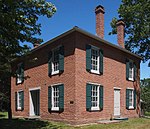DTN (company)

DTN, previously known as Telvent DTN, Data Transmission Network and Dataline, is a private company based in Burnsville, Minnesota that specializes in subscription-based services for the analysis and delivery of real-time weather, agricultural, energy, and commodity market information. As of 2018 the company has approximately 600,000 subscribers, mostly in the United States. DTN is known for its accurate meteorological forecasting and large network of weather stations, its market analysis services, and its early use of radio and satellite systems to transmit reports to its Midwestern consumers. DTN also operates The Progressive Farmer magazine. DTN was previously owned by Telvent and Schneider Electric, and since 2017 has been owned by Zurich-based TBG.
Excerpt from the Wikipedia article DTN (company) (License: CC BY-SA 3.0, Authors, Images).DTN (company)
Rupp Drive,
Geographical coordinates (GPS) Address Nearby Places Show on map
Geographical coordinates (GPS)
| Latitude | Longitude |
|---|---|
| N 44.7973 ° | E -93.2564 ° |
Address
Rupp Drive 11400
55337
Minnesota, United States
Open on Google Maps








